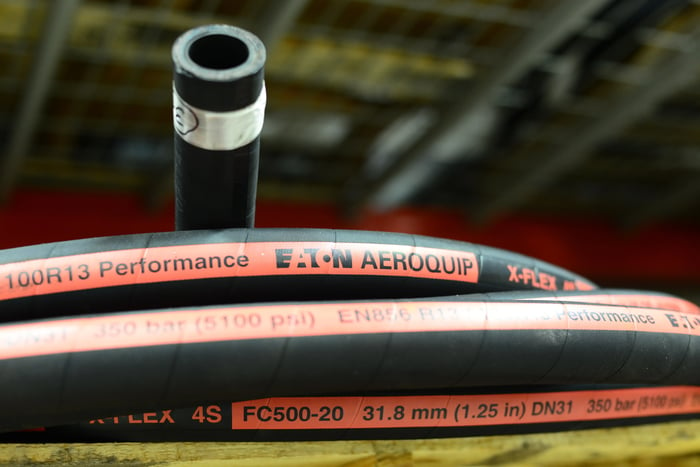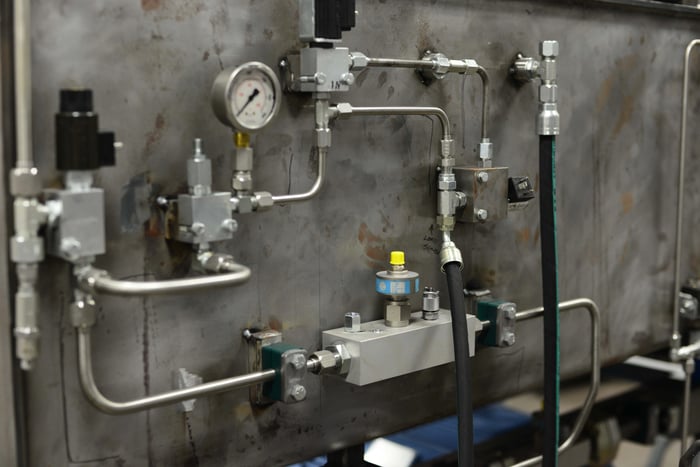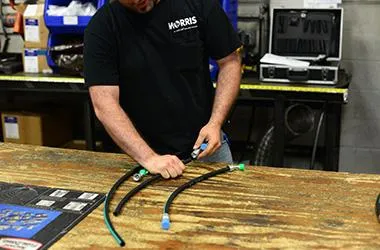Choosing the Right Hydraulic Hose
Understanding the S.T.A.M.P.E.D acronym for selecting the proper hose
with collaboration from AirHydraulic Systems and Power Systems. Image above provided by SG Morris.
S.T.A.M.P.E.D. stands for:
- Size
- Temperature
- Application
- Material/media
- Pressure
- Ends
- Delivery
S: Hydraulic hose size – interior dimension and exterior dimension
S stands for size, which refers to both interior and exterior dimension. The interior dimension is important in basically any application because it directly impacts flow. Fluid will be forced to flow faster through smaller hose, so the interior dimension has to match the desired fluid velocity for the system. If fluid is allowed to flow too quickly, it can result in a turbulent flow which increases the amount of heat the system generates. For more information on heat, read “Avoiding Hydraulic System Failure: Keep Hydraulic Oil Cool.”
To prevent damaging hose abrasion, hoses are sometimes clamped in place to prevent rubbing against other components of the machine. In this case, the hose needs to be the correct size so the clamp can effectively hold it. If the clamp is too small, the hose will rub against the inside of the clamp and cause abrasion, if it’s too small, then it can’t be used at all.
More importantly, however, is the minimum rated bend radius of the hose. This refers to the curvature radius of the hose when it’s bent to a full 90 degrees. If a hose is bent any further than this radius, which is specified by the manufacturer, the strain will cause it to break down prematurely. A thinner hose tends to have a smaller minimum radius, which allows it to bend around tighter corners than thicker hose. In this way, thinner hoses are easier to route through tight spaces than larger hoses.
Length is also important, obviously the hose is useless if it can’t span the gap between the two connection ports. Where length is concerned, the fittings have to be considered as they will add to the overall length. It is important to note that hoses contract under pressure, so there needs to be enough extra length to allow for this contraction without stretching the hose and putting strain on the fittings.
 Interior and exterior dimensions of the hose will make a significant difference to the performance.
Interior and exterior dimensions of the hose will make a significant difference to the performance.
T: Temperature – fluid temperature and ambient temperature
Next up is temperature. Like size, there are two temperatures to consider, both the temperature of the fluid flowing through the hose, and the ambient temperature where the machine is operating.
Extreme fluid temperatures can break down the inner tube of a hydraulic hose. This normally takes the form of a hardening followed by a cracking of the inner lining. Once this happens, the hose will most likely burst under the pressure of the fluid. To avoid this, it is important to know what the temperature of the fluid will be at any given time in the machine. In the “good-better-best” model, a typical “good” hose will have a range of between -30 and 200 degrees F or so. If the fluid temperature is expected to go higher than that, the hose may have to be upgraded to the “better” or “best.” For example, Teflon hoses are often rated for fluids of over 300 degrees F.
In addition, the temperature surrounding the hose needs to be considered. In industrial situations where the hose is inside a climate controlled building, this may not be an important factor. However, if a hydraulic hose is used on the outside of a snow plow, for example, considerations must be made for the low temperatures. Inversely, hoses used on an engine block will have to be rated to a very high ambient temperature.
A: Application – hydraulic system application
Application is more broad and vague, but is important never-the-less. Simply put, the Application section accounts for all the factors that are missed by the rest of S.T.A.M.P.E.D. The best way to illustrate this is with a couple examples:
Consider a hose on the compactor blade of a garbage truck. The blade is attached to the arm assembly, which moves up and down regularly during use, meaning that the hose connected to the blade is bending as it follows the motion of the arm. While some bending was covered in the “size” section of this article, that didn’t necessarily address the constantly changing shape of the bend. So this hose will have to be thin enough to bend to the necessary radius, but must also stand up to the regular changes in shape.
Now consider a hose used in a foundry. This hose may have to withstand the occasional contact with molten metal thrown free of the machinery. For this application, an extreme abrasion resistant hydraulic hose will need to be considered.
 See in this image two examples of hoses using bent or ninety-degree fittings. These fittings allow the hoses to attach at extreme angles without stressing the hose or fitting.
See in this image two examples of hoses using bent or ninety-degree fittings. These fittings allow the hoses to attach at extreme angles without stressing the hose or fitting.
M: Media/Material – hydraulic fluid media, hydraulic hose material
M stands for media/material. Basically this refers to the type of liquid the system uses and what material can best handle it. The hose material and the fluid have to be “chemically compatible” or the hose will break down. Suffice to say, the hose material has to be able to withstand any possible corrosive effects of the media. For example, a standard rubber hose may have no problem conveying hydraulic oil, but may break down if it’s used with a kerosene based fluid.
P: Pressure – hydraulic system pressure
The P stands for pressure. It goes without saying that high pressure systems will need stronger hoses to contain the fluid without causing a burst. This may go hand in hand with exterior and interior dimension given that the walls of the hose will need to be thicker if the pressure climbs too high.
The hose should be able to handle the highest pressure that the system will reach or it will result in damage to the machine, or premature burn-out of the hose. This includes pressure spikes as part of normal operation. If the operating pressure of a system is 500 PSI for example, but it is known to have occasional spikes of 750 PSI, then a hose rated to 650 PSI would be insufficient despite being higher than operating pressure.
E: Ends – hydraulic hose fittings/ends
E stands for ends, and refers the hydraulic hose fitting on each end of the hose. There is a lot to consider when looking at this step of the process. Obviously, the fittings need to match the ports they are intended to fit. Selecting this should not be a difficult process. Simply looking at the specs of the ports in question will provide the hose supplier all necessary information to get the proper ends installed on the hose. Routing also has to be considered. If the hose has to make a sharp turn immediately, for example, then a 90-degree fitting should be considered to take some strain off the bent hose.
Just like with M above, there is a chemical compatibility chart that must be addressed when selecting fitting material. The wrong fluids could corrode and break down the metal parts of the hydraulic hose connector. The common materials for metal fittings are: Carbon plated steel, stainless steel, steel, brass, and sometimes aluminum. Each of these have different specification and costs associated with them. For example, as a soft metal, brass hydraulic fittings should only be used for low pressure systems. Stainless steel hydraulic fittings, on the other hand, can withstand a much higher pressure, but may be more expensive.
D: Delivery
The final section is D, which stands for delivery. This refers to the shipping of the full hose assembly to the customer location and will vary based on the supplier and the buyer.
Get Connected TodayApplied Fluid Power has locations all over the country standing ready to help you select the exact hose for your needs. Contact us today to get started. |

|


